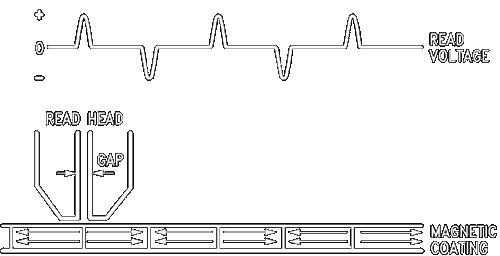This floppy drive is made of mostly standard parts... its functionality, down to the read/write amplifiers, is clearly described.
Note, however, its formatting is *very* different from a standard PC floppy.
From a quick-glance, this drive seems to store data bits directly-serially. No MFM, FM, etc. A '1' bit is encoded by a change in flux, while a '0' bit is no change. [Maybe it uses whatsitcalled, where data bits are encoded such that consecutive zeros are never encountered? But, no, it refers to 8 data bits... hmmm].
Further, it doesn't appear to store *any* clocking data on the disk, relying on a perfect 300RPM spindle rotation, storing bits [actual data bits] at around 1MHz. I say "around" because it actually stores bits denser on outer tracks, which means changing the clock frequency.
Again, *very* different than most floppy drives I've encountered. I'm a bit surprised it can even function. Do I have this right, or does the counter divide the clock further? 1Mb/s, 300RPM... 300/60=5 rotations/sec, 1/5=200kb/track 35 tracks, 7Mb/8=~1MB... seems a bit high... maybe that 7493 divides the clock.
Still, this system relies on near-perfect 300RPM, which is accomplished via DC [brushed?!] motor and a tachometer/feedback-loop... which... I'm not saying 300RPM couldn't be maintained, but we're also talking about a motor/tach combo tied to the spindle via belt, and also talking about a brushed motor, with a commutator and varying power at different rotational angles... I mean, WOW! 300RPM, *constant* throughout a rotation!
And, frankly, throughout *multiple* rotations, as it reads multiple sectors?! There must be more to this. Resynchronization at the bit-clock level [maybe via index?]
----
Anyhow, it suggests many things in favor of Floppy-bird...
First-off, an idea how read-amplifier circuitry works... this, combined with the seeming fact of multiple-'0's/varying-flux-transition-densities in this system may give some insight into whether my pwm-nibble scheme with its varying flux-density is even feasible [maybe at a much slower rate/data-density than originally planned]; as I recall, I last encountered randomish read-back data from what appeared to be related to too-distant flux changes causing automatic-gain to amplify minor flux variations within a single polarization along the track. While that *may* be the case, here we have a system-design that doesn't seem to have automatic-gain, yet still has widely-varying flux-transition-density, which could rule that out.
I have other reasons to rule that out, as well, such as consideration that my PWM-nibbles were designed to fit within only a *slight* stretching of the timing-specs of the drive/disks I'm using. And, further, that a 1.44MB floppy drive is also capable of using 720KB disks, whose flux-change-density [vs. Time] varies further-still. [However, I hear the magnetization of the two varies].
Also, flux-changes can result in a very short pulse in the read-coil's voltage, followed by a comparatively-long 'zero'-output before the next change.

(From an excellent resource: https://info-coach.fr/atari/hardware/FD-Hard.php#Sense_Amplification_and_Conversion_Circuits)
However, there's also mention that higher densities may be less-defined, which may require more active sense-amplifier circuitry [automatic gain/offset?], and combining that with MFM's assuring *maximal* density... well, it's still kinda up in the air.
I'm pretty sure I gained more insight than this from that service manual, but I'm blanking, now...
 Eric Hertz
Eric Hertz
Discussions
Become a Hackaday.io Member
Create an account to leave a comment. Already have an account? Log In.